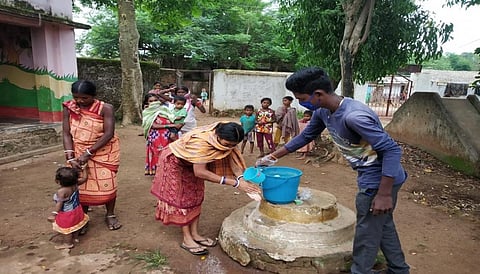CSE-trained professionals prepare India’s first rural water and sanitation safety plan
Safe water and access to safe sanitation plays a vital role in sustaining life as clean and safe drinking water, hygiene and sanitation are necessary in our daily lives. Decline in water quality impacts human health as well as natural ecosystems.
In many urban, peri-urban and rural areas, water-related diseases are caused due to unsafe sanitation facilities as well as unsafe management of wastewater that increases health risks. Water and Sanitation Safety Plan (WSSP) is a key resource to emphasise the combined issues of water and sanitation.
WSSP is an internationally recognised practice for assessing and managing public health risks related to water supply and sanitation systems. It is a risk assessment tool to safely manage water supply and sanitation systems.
It considers multiple factors such as behavioural, managerial and technological to prevent exposure to hazardous events affecting water and sanitation quality.
WSSP also acts as a monitoring tool and provides control on different factors throughout the water supply and sanitation chain.
India’s first rural WSSP was prepared by a Kolkata-based non-profit organisation called SIGMA Foundation, with the support of the Government of West Bengal and the Asian Development Bank (ADB).
This WSSP was prepared under a statewide initiative of ADB in which the School of Water and Waste (SWW) at the Centre for Science and Environment (CSE) was engaged as a technical support partner to capacitate local non-profits involved in the WSSP preparation.
Based on the collaboration with ADB, CSE trained the representatives of the ADB programme partner agency representatives for six weeks to help them prepare a draft WSSP for their Gram Panchayat (GP) at the end of the training period.
MN Roy, president of the SIGMA Foundation is an ADB programme partner. He presented his experience at the Second Alumni Impact Workshop August 12, 2021.
Roy shared a case study on preparing a WSSP for the Brahmandiha GP of Bankura district in West Bengal. In recognition of the work done for preparation of India’s first rural WSSP, SIGMA Foundation was conferred the ‘Water Champions Award – 2021’ by CSE.
According to Roy, the Government of West Bengal, through the West Bengal Drinking Water Sector Improvement Project (WBDWSIP), aims to provide safe, reliable and continuous drinking water to about 2.6 million people in selected arsenic-, fluoride- and salinity-affected districts of West Bengal.
The WBDWSIP will help supply continuous potable drinking water to 66 GPs. Of these, three GPs — Brahamandiha, Birulia and Gopalpur — were considered for preparing sample WSSPs under the CSE-ADB collaboration. The ADB also engaged the World Health Organization (WHO) in this project and these sample WSSPs were closely monitored and reviewed by WHO and CSE.
Roy said drinking water safety guidelines had been prepared by ADB for the entire state of West Bengal. These stressed upon requirement of separate WSSPs for the GPs in the state.
The Brahamandiha WSSP (one selected among three sample WSSPs) identified several grey areas in the GP region: Unsafe surface water, unhygienic sanitation practices, drying aquifer, low sanitation awareness and lack of solid liquid waste management.
Diseases prevalent in the area included: Diarrhoea, Japanese Encephalitis / Acute Encephalitis Syndrome, malaria, dengue, respiratory tract infection, skin diseases, etc.
The WSSP preparation involved a five-fold process:
1) Preparation: The boundary of WSSP was defined, with objectives and indicators for monitoring. More than 3,000 households were surveyed and health risks posed by all the potential hazards was assessed using a template provided by CSE across the value chain of water supply from source to mouth and covering all aspects of insanitary conditions.
2) System assessment: Risk assessment was carried out using a Risk Score Matrix based on two parameters: Frequency of hazard occurrence and public health impact severity.
The exercise identified 32 hazardous events (11 associated with water and 18 associated with sanitation). Some 27 control measures were identified to be put in place to reduce the risks.
3) Monitoring: Eight objective indicators were laid to judge the plan effectiveness. Usage of technology through Smart Water Management was designed to capture the output result for a few laid parameters.
4) Management and communication: A standard operating procedure was developed to define control measures and what needs to be done to control the risk. Communication for implementation of the programme for behavioural change and strengthening governance of the GP was laid down.
5) Feedback: A review and its updating process was defined for effectiveness of the WSSP.
However, a number of challenges also presented themselves during the preparation of the first rural WSSP. Poor sanitation infrastructure, the inhabitants’ attitudes, lack of capacity and the COVID-19 pandemic were a few of them. Also, the GP gave less importance to preventive measures as there was no tangible outcome.
The Brahamandiha WSSP was launched on March 15, 2021 on the ADB-E Market Place under the theme Catalyzing Innovations and Digitization for Safe, Sustainable, Resilient, and Inclusive Water Management.
This document can help other GPs in West Bengal to replicate the benefits of the exercise for improved delivery of WASH services, along with all possible interventions to manage public health risks.

